Initially this guide displays common birds of all types that are flying right now in our area. Use the selectors below to view rare birds, view birds flying any time, restrict the output to a certain shape of bird, or search by name.
New Mexico is on the western edge of the Central Flyway which is one of the major migration pathways between north and south for birds traveling between breeding and wintering grounds along the Rocky Mountains. This has resulted in the state having an incredible diversity of birds with over 550 different species reported. A little more than half of this number are sighted annually on the Pajarito Plateau. Some of these birds are full-time residents, some migrate here for a few weeks or months, and other are only seen briefly as they pass through the region.
This guide features many of the birds known to frequent Los Alamos county by when they are likely to be seen in the area. You can get additional information on local birds by joining PEEC Birders or going to the eBird website. eBird also includes lists of rare bird sightings and birding hot spots.
Bird References
Birdweb
Cornell Lab of Ornithology
eBird
eNature
Institute for Bird Populations
National Audubon Society
New Mexico Ornithology Society
What Bird
xeno-canto
Subject Area Experts (all guides)
Steve Cary (butterflies)
Beth Cortright (insects)
Terry Foxx (invasive plants)
Leslie Hansen (mammals)
Richard Hansen (fish, mammals)
Dorothy Hoard (butterflies, trees)
Chick Keller (flowers, herbarium)
Shari Kelley (geology)
Kirt Kempter (geology)
Garth Tietjen (reptiles)
David Yeamans (birds)
Web Development and Content Management
Pat Bacha
Jennifer Macke
Graham Mark
Akkana Peck
Contact
Please contact us for local nature questions and sightings. We welcome comments, corrections, and additions to our guides.
For more information about local nature, please visit our Nature Blog or subscribe to PEEC This Week.
Make Selection
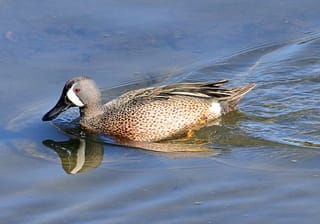 Photo: breeding male by Bob Walker 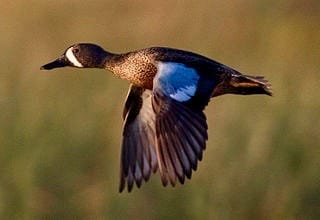 Photo: breeding male by Dan Pancamo 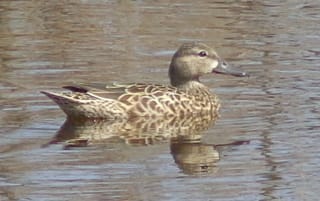 Photo: female by C.M. Edmunds |  Blue-winged TealBWTE (Anas discors)Family: Anatidae (Ducks and Geese) Size: 15 - 16 in (38 - 41 cm) Flies: Apr 01 - May 15 and Aug 15 - Oct 15 Morphology: breeding males have a brown body with speckled breast, a slate-colored head, and white crescent behind the bill; females and non-breeding males are a patterned brown; all birds have a blue patch on their upper wing showing during flight Status: native; uncommon Food source: mostly plant material, in particular seeds; may occasionally eat mollusks and crustaceans Habitat: fresh ponds and marshes Typical location: Ashley Pond The Blue-winged Teal is closely related to the Cinnamon Teal and may hybridize with it. These teals are fast fliers and flocks will twist and turn in unison. These birds are dabblers and thus forage in shallow water. They often move along with their heads partly submerged, in order to glean food from at or near the surface. They seldom feed away from water but small groups of these teals can be seen standing on stumps or rocks near the water’s edge. Pairs form in early winter and continue together through spring migration. Nests are well concealed and consist of a shallow depression with lined with grasses and down. The eggs hatch in a little over 3 weeks; the young leave the nest within 24 hours and are capable of flight in a little over a month. Tracks Info Photos Distribution Frequency |
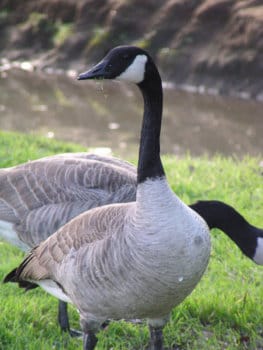 Photo: adult by Akkana Peck 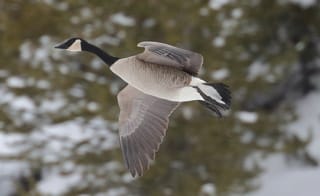 Photo: adult by Bob Walker 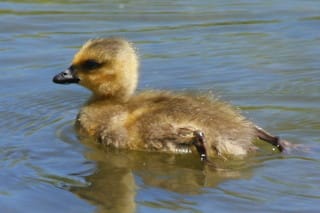 Photo: gosling by J.N. Stuart |  Canada GooseCANG (Branta canadensis)Family: Anatidae (Ducks and Geese) Size: 35 - 45 in (89 - 114 cm) Flies: Jan 01 - Dec 31 Morphology: both sexes have a black head with white cheeks and chinstrap, black neck, tan breast, and brown back Status: native; uncommon Food source: feeds on a wide variety of plants including aquatic plants; eats seeds and berries along with some insects and small fish Habitat: lakes, bays, rivers, marshes, open grassy areas Typical location: Rio Grande Canada Geese are known for their V-shaped migrating flocks and can be seen flying overheard. There are several subspecies that vary in size and calls. They mostly forage in flocks, grazing while walking on land but will also feed in water, sometimes up-ending but usually only submerging head and neck. They have adapted well to being around man, favoring the areas around park ponds and golf courses. This had caused them to be a nuisance in some areas. Canada Geese may mate for life. The female choses the site, usually on slightly elevated dry ground near water, while the male defends the territory. The nest consists of a shallow bowl lined with sticks, etc. in a slight depression. Young are lead away from the nest a day or so after hatching. They feed themselves from then on but are tended by both parents until first flight, usually at 7 to 9 weeks of age. Tracks Info Photos Distribution Frequency |
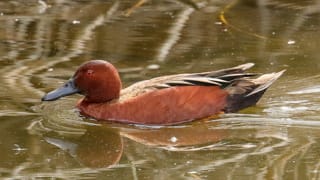 Photo: breeding male by Bob Walker 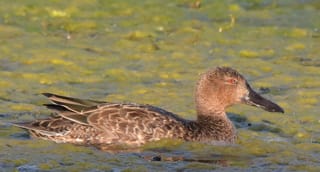 Photo: non-breeding male by Steven Mlodinow 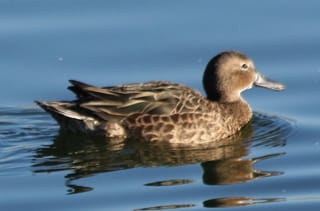 Photo: female by J.N. Stuart |  Cinnamon TealCITE (Anas cyanoptera)Family: Anatidae (Ducks and Geese) Size: 15 - 16 in (38 - 41 cm) Flies: Mar 01 - May 01 and Aug 01 - Oct 01 Morphology: breeding male has bright cinnamon head and body with dark rump and red eyes; non-breeding male is rusty, gray-brown overall with red eyes; female is gray-brown overall with dark eyes and mostly dark beak Status: native; rare Food source: mainly plants but may eat mollusks and aquatic insects Habitat: ponds and marshes Typical location: Ashley Pond The Cinnamon Teal is a brightly colored duck closely related to the Blue-winged Teal and may hybridize with it. As a dabbler, this duck forages in shallow water, swimming with its head partially submerged while skimming food from the surface. These birds may be seen following one another, taking advantage of food that has been stirred up by the paddling of others. Nests are often camouflaged below matted vegetation. The female will then enter the nest via a tunnel through the vegetation. Incubation time is 21 to 25 days. The female will lead the young to water immediately after hatching. The young can fly at about 7 weeks. Tracks Info Photos Distribution Frequency |
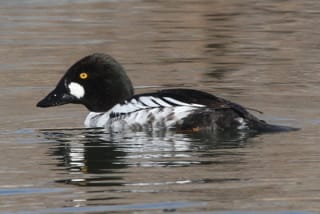 Photo: male by J.N. Stuart 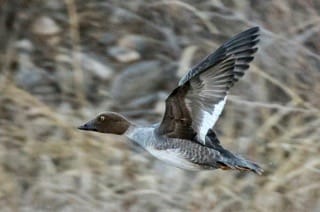 Photo: female by Mouser Williams 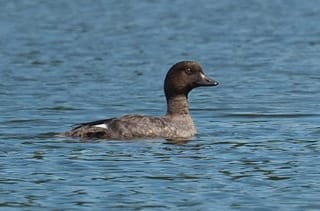 Photo: immature by Jakob Fahr |  Common GoldeneyeCOGO (Bucephala clangula)Family: Anatidae (Ducks and Geese) Size: 16 - 20 in (41 - 51 cm) Flies: Nov 17 - Mar 07 Morphology: medium-sized duck that has a large head, small, narrow bill, and a large white patch in the wings that shows during flight; males are mostly black and white with a round spot near a black bill and bright yellow eyes; females have brown heads, gray backs and wings, and yellow eyes; immatures are similar to females except for dark eyes Status: native; locally common Food source: eats crustaceans, small fish, aquatic insects, and some plant material; diet varies with seasons Habitat: wooded lakes,ponds Typical location: Rio Grande Common Goldeneyes are robust diving ducks that mostly forage underwater and are capable of diving to depths of 20 feet (6 meters). These birds are often seen in flocks and, when feeding, all of the birds in one area may dive at the same time. Pairs usually form in late winter. Females often return year-after-year to the site where they hatched. Nests are typically in tree cavities high above the ground. Young leave the nest a day or two after hatching and are led to water by the female. They can fed themselves immediately but are unable to fly until about 2 months old. Tracks Info Photos Distribution Frequency |
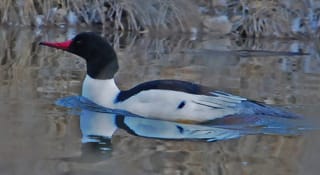 Photo: male by Jerry Oldenettel 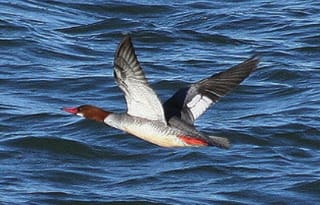 Photo: female by Mouser Williams 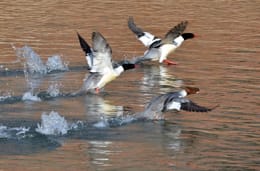 Photo: males and female by Kevin Arceneaux |  Common Merganser, GoosanderCOME (Mergus merganser)Family: Anatidae (Ducks and Geese) Size: 22 - 27 in (56 - 69 cm) Flies: Dec 07 - Mar 15 Morphology: both sexes are long-bodied with thin, pointed wings and straight, narrow bills; males have white bodies, iridescent green heads, black backs, and red bills; females have gray bodies with a white chest and rust-colored heads with a shaggy crest on the back of the head Status: native; locally common Food source: adults eat mostly fish but will eat mussels, shrimp, salamanders and rarely plant material; young eat aquatic insects Habitat: along water ways Typical location: Rio Grande The Common Merganser is the largest of the three mergansers in North America. While these birds may swim on the water surface looking for food, they are “divers”, completely going underwater to obtain their prey. Their bills have serrated edges that helps them grip fish and other small animals. During courting, a male will swim very rapidly in circles near a female and then stretch its neck up and give a light call. Nests, made of wood chips or other debris, are located near water in a cavity or crevice. Young leave the nest a day or two after hatching by jumping from the nest to the ground. They can feed themselves right away but cannot fly for about two months. Tracks Info Photos Distribution Frequency |
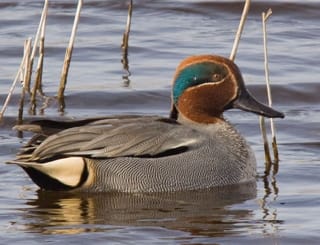 Photo: male by oldbilluk 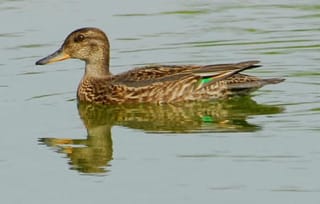 Photo: female by David Blanke 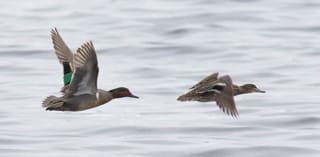 Photo: pair by Matt Goff |  Green-winged TealGWTE (Anas carolinensis, Anas crecca, Anas crecca carolinensis, Anas carolinensis carolinensis)Family: Anatidae (Ducks and Geese) Size: 12 - 16 in (30 - 41 cm) Flies: Jan 01 - May 15 and Aug 07 - Nov 01 Morphology: breeding males are gray with a cinnamon head and green line through the eye; females and non-breeding males are shades of brown; both sexes have green patches on the upper wing Status: native; uncommon Food source: plant material, especially seeds; will feed on insects, crustaceans, mollusks, tadpoles, and fish eggs Habitat: marshes, ponds and lakes Typical location: Bandelier Sewage Lagoons Though officially classified as the Common Teal (Anas crecca) by some authorities, the Green-winged Teal is considered a separate species (Anas carolinensis) by many others. It is the smallest dabbling duck in North America and winters in the local area in large flocks. These teals prefer to forage on mud flats. At the slightest sign of danger they will take off, rising almost vertically from the water. They migrate north early in spring for breeding. Nests are made in shallow depressions. Eggs hatch in 3 weeks with the young leaving the nest almost immediately and flying at 6 weeks. Tracks Info Photos Distribution Frequency |
 Photo: male by Hari Viswanathan 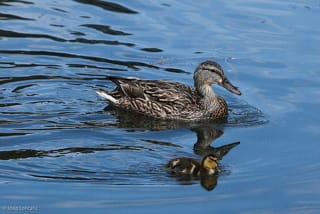 Photo: female with duckling by Josip Loncaric 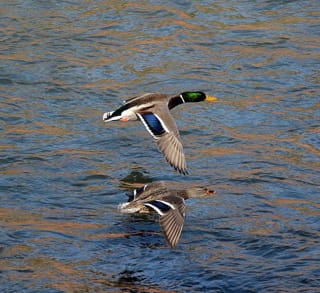 Photo: female and male by Kevin Arceneaux |  MallardMALL (Anas platyrhynchos)Family: Anatidae (Ducks and Geese) Size: 18 - 27 in (46 - 69 cm) Flies: Jan 01 - Dec 31 Morphology: males have a brown breast, black back, iridescent green head, and yellow bill; females and immatures are mottled brown with brown to orange bills; both sexes have blue patch in the wing Status: native; locally common Food source: eats mainly plant material including seeds, stems, and roots along with insects, mollusks, crustaceans, and small fish; ducklings mostly eat aquatic insects Habitat: marshy areas Typical location: Bandelier Sewage Lagoons, Rio Grande The Mallard is the most well known of wild ducks and the ancestor of most strains of domesticated ducks. Mallards are dabbling ducks, meaning that they usually feed either on the surface of shallow water or tip headfirst into the water to find aquatic vegetation and insects. Pairs form in fall and winter and seek a nesting site together. The nest, consisting of plant material lined with down, may be some distance from water but is usually on the ground concealed by vegetation. Young leave the nest within day of hatching and are able swim and feed themselves immediately. Tracks Info Photos Distribution Frequency |
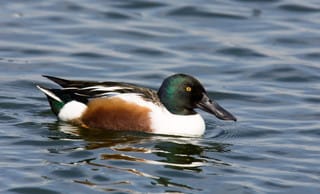 Photo: breeding male by Greg Lasley 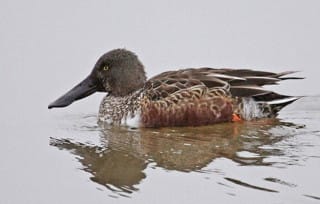 Photo: nonbreeding male by Jerry Oldenettel 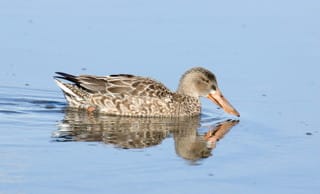 Photo: female by Greg Lasley |  Northern ShovelerNSHO (Anas clypeata)Family: Anatidae (Ducks and Geese) Size: 17 - 20 in (43 - 51 cm) Flies: Apr 15 - May 15 and Sep 01 - Sep 21 Morphology: flat-billed birds with a rear that sits a bit high out of the water; breeding males are bright white, blue, green, and rust with flashes of blue and green showing during flight; nonbreeding males have subdued coloring of black and brown with brown markings; both breeding and nonbreeding males have black bills; females and immatures are mottled brown with an orange bill and light blue on the wings Status: native; rare Food source: diet varies with the season; mostly seeds and aquatic plants in winter; primarily mollusks, insects, crustaceans, and sometimes small fish in summer Habitat: favors water edges with dense vegetation Typical location: Bandelier Sewage Lagoons The Northern Shoveler is sometimes referred to as “Spoonbill” or “Spoony” due to its unique spatulate-shaped bill. Like many dabbling ducks, Northern Shovelers use their flat bills to strain food from the water while slowly swimming forward with the head partly submerged. These ducks occasionally work in a group, swimming around in a wide circle to bring food to the water surface. Mating pairs form in winter or during spring migration. Several males may court one female. In this case, the female makes her choice by flying away with one of the males. Nests are usually close to water in a grassy area and consist shallow depressions filled with dried grasses and lined with down. Young are led to water within a few hours after hatching. They are able to fly at about 2 months of age. Tracks Info Photos Distribution Frequency |
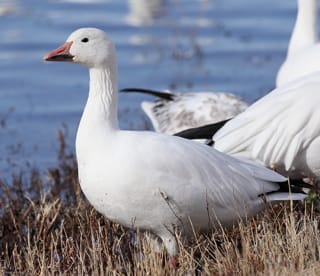 Photo: adult, snow variant by Josip Loncaric 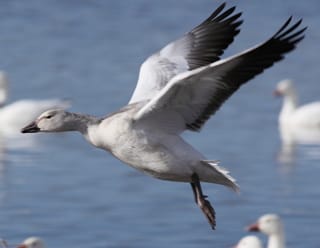 Photo: immature, snow variant by Josip Loncaric  Photo: adult, intermediate form by Greg Lasley |  Snow GooseSNGO (Chen caerulescens)Family: Anatidae (Ducks and Geese) Size: 25 - 31 in (64 - 79 cm) Flies: May 07 - May 21 and Dec 01 - Dec 15 Morphology: snow variant - white-bodied birds with black wingtips that are more noticeable in flight and a pink bill with a dark line along it; white immatures have a dark bill and some gray on head, neck, and wings; dark variant also known as a “blue goose” - dark brown bodied bird with white face and white under tail; immatures are similar to adults but still smaller in the fall Status: native; uncommon Food source: almost entirely plant materials — seeds, leaves, roots, and some berries Habitat: stop-over spots of open fields with water nearby Snow Geese are commonly only seen together in large numbers. They pass through the local area during migration on their way to winter in Bosque del Apache. However, during migration they fly so high that they can hardly be seen. Their typical flight pattern consists of shifting curved lines and arcs. Snow Geese usually forage by walking in shallow water or on land, sometimes mixed in with other geese. These birds may mate for life and usually nest in colonies in the extreme North. The two color forms mate with each other and can produce young of either color or an intermediate form. Tracks Info Photos Distribution Frequency |
